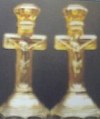Carnival Glass 101 | home Quick Reference to Carnival Glass Patterns on This Site
Wake Up Call
WAKE UP CALL!-------to focus on “extra-curricular activities”!
With all due respects to a great many authors for their written information regarding Fenton manufacture; facts have been duly stated in any number of previous written accounts spanning the years since Carnival Glass became a collectible. We must conclude that the downside of altering factory-made merchandise has not been appropriately addressed. We should all be familiar with the indented impressions or the straw mark within the marie or collar base, found in the usual Fenton bowl/plate. Frank M. Fenton was quite thorough in his explanations of variations in production., whether it be during a private discussion or one of his numerous convention presentations.
We are not here to question base areas clearly displaying manufacturing flaws we all know to exist and take for granted.
Allowing for the “turns and half turns” in producing plates per se', a focal point for discussion is that there were always more bowls than plates produced; indicating that perhaps the only time a plate emerged from factory premises while “the run” was in production, was when a bowl was too hot to maintain shape and was quickly flattened out with the apple wood paddle in order not to lose all effort in creating a saleable item. Certainly, in many Fenton patterns, plates are a very scarce/rare commodity.
It must also be noted as doubtful that Frank M., who instigated the Fenton Museum would have included any of these “makeovers” as we know them to be. He would have taken note of their obvious deviations very quickly…………and not purchased them for display! Frank was an astute buyer among his other fine traits.
A very good case in point, when discussing what Brian Pittman has referred to as “Con-Carni”, is the marigold Wild Blackberry example shown in this segment. It has all the earmarks of a “con-artists' work”. We have specialized in and own more than 200 Fenton plates. They have intrigued us for more than 35 years. NONE of them portray “egg plate syndrome”, somewhat ruffled edges; nor indication of a reworked exterior, and re-spray.
In some examples of these re-makes, the overspray has obviously been “applied of late”, including two such re-makes we have handled, which clearly display that overspray extends onto the interior of the collar base! This, of course indicates “a sprayed lately” situation, because factory use of the snap over the collar base prevented such sloppy overspray!
Having grown to adulthood in Parkersburg, WV., amid the multitude of glassmaking facilities found all over the Ohio Valley, we have become admirers, as well as close observers of the irrefutable deviations outside the “norm”, while personally conducting research, taking photos, and selecting examples for our own collection.
This is a very good place to inform you that there are “former large glass operations employees” living throughout KS, KY, OH, PA, TN, WV, with knowledge and ability to alter glassware, extending to the reheating and coercion of former ruffles into a rather drooping and flattened result. The old National Rt. 50, leading East out of Parkersburg to Clarksburg and Pennsboro, WV are lined with small “garage operations” sitting next to their owners' homes. Inside, you will find all the production mechanics required to produce fine glassware from “scratch”. During the late 1950s, we purchased one such clear glass pitcher from such a garage! Years later, after we had moved to San Diego in 1970, that man turned his operation into what became a very successful party plan for selling his glasswares. (We are not inclined to name names here.)
Karg Art Glass Studios, located in KS has conducted sessions of this “re-shaping” process for the Air Capitol Convention group and will be performing another session surrounding the application of iridescence during the Oct. 2009 Club Convention in Wichita.
There is at least one large reproduction facility in NC which has become most adept and well known for its ability to re-create new examples from old glass and china patterns……and “one-of-a-kinds”.
As with other collectibles there is a dark side to Carnival Glass, whether we choose to believe that or not. First inclination for those of us who perform our daily functions with forthright honesty, is to disbelieve that devious activity exists, such as we are about to state! As Paul Harvey would say, “Now! Here is the REST of the story!” Before we launch into actualities, please allow us to inform you that according to legend and truth, there is always more than one way to “skin a cat”, and more than one individual who will and has accomplished the feat! Money is the root and basis of all evil! That dictum is centuries old.
With that in mind, along with the fact that whoever the current perpetrators are, we know that they have a great knowledge of just which Fenton plates are non-existent, scarce, or will bring the most return!! (The likely story that a long deceased relative who worked for Fenton in the early days, created these “plates” should be cause enough to “wonder”?) NO-ONE that long ago could possibly have been versed in the scarcity of certain patterns in plate form today!! When several thousands of dollars are to be gained from transforming a $50 bowl, there are those who use implements leaving telltale tool marks and burned areas on the exterior, in their haste to complete “the action”! Application of over spray to cover those problem areas, which does not match the OLD ORIGINAL finish for lack of firing, should create direct suspicion on any collectors' part! Reports from time to time indicate some of these makeovers come back from foreign places. (We've been told that one example came from the British Isles.) This brings up another point of discussion: Items coming from foreign soil avoid the intrastate/interstate laws surrounding fraudulent activity.
The first such makeover came to our attention in 1993 while attending the Lexington, KY sale conducted by Jim Seeck for Richard Hagood. That example was “the first” Dragon & Lotus spatula footed “plate” with most obvious tool marks and visible former ruffling. In addition to those collectors in attendance, at least a couple of well-known carnival glass “dealers” recognized those ravages and the piece sold for very little. We traveled from San Diego with a $5000 check from Ardonna Bucher for the purchase; only to discover the adverse effects of the makeover.
Since that day, we have handled what is becoming an alarming number of fraudulent “plates”. We have been threatened by one seller, when confronting him about such activity, and the practice continues. Ebay is the perfect venue for such, when only the claim that “it is old glass” accompanies the description. Buyer BEWARE!
Please understand: this practice is not new, but ongoing! Since that first Dragon/Lotus, we have handled at least a dozen others in various patterns, five of which were present during the 2006 ACGA Convention in Parkersburg. Four of them were for sale in rooms. The fifth one is in private hands, having been purchased during a May 2006 auction in Ohio. That owner now realizes his failure to comprehend the “strangeness” of the exterior at time of purchase, and stated his disdain while speaking out against this sort of activity during the ACGA business meeting. A former Pres. of ACGA, and a resident of Williamstown, living not far from the Fenton Factory, personally inquired of one of the glassworkers he knows, about the feasibility of reheating/reshaping carnival glass. His reply was in the affirmative. “It most certainly can be done, resulting in the characteristics of altered surface area.” This too, was brought out during that business meeting. The gradual reheating is accomplished from “unconventional sources”. It is that process which produces the burned areas on the exterior, along with the bruising tool marks. Some of these later “plates” are becoming somewhat less obvious. (As in: practice makes fewer telltale results?).
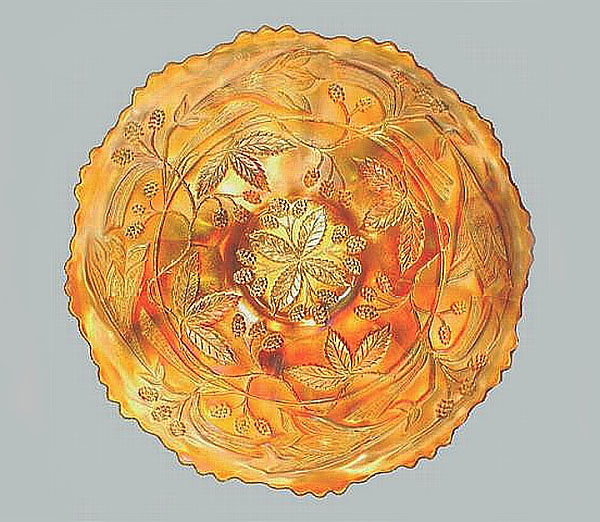 |
|
WILD BLACKBERRY (former bowl)
|
|
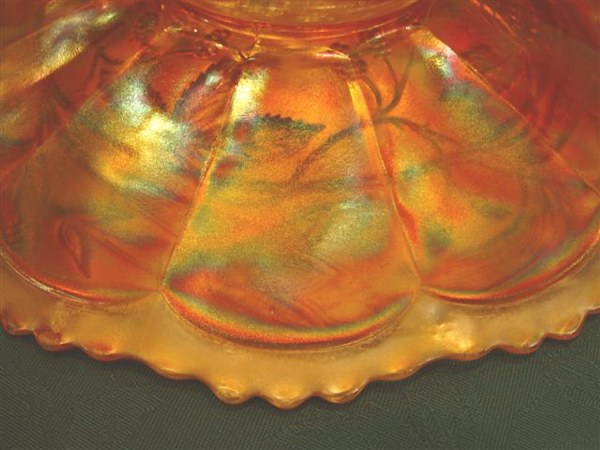 |
|
Overspray does not match original factory application.
|
|
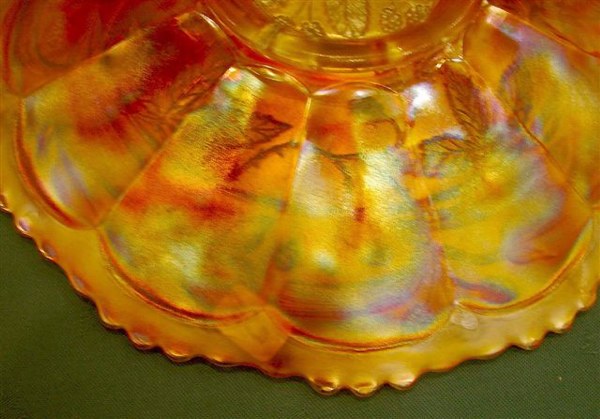 |
|
Obvious splotchy application of bright mgld. overspray.
|
|
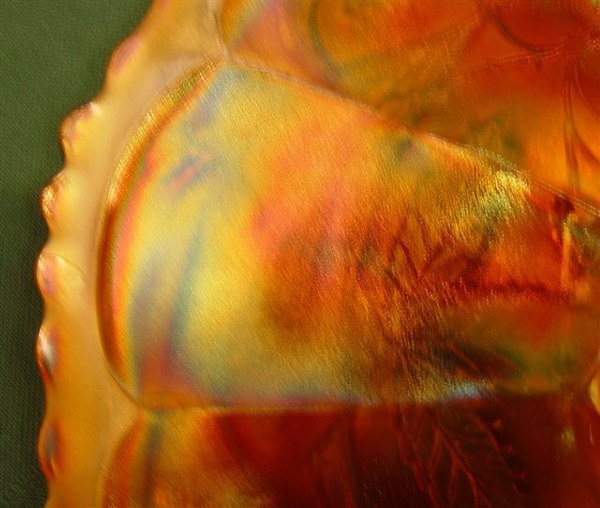 |
|
This respray is splashed all around the exterior panels.
|
|
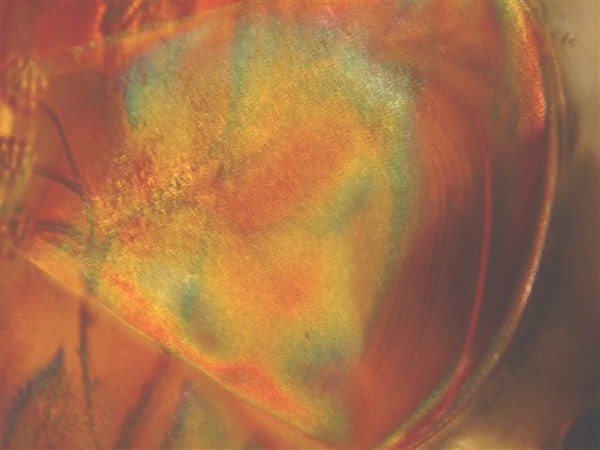 |
|
SPLOTCH (personna).
|
|
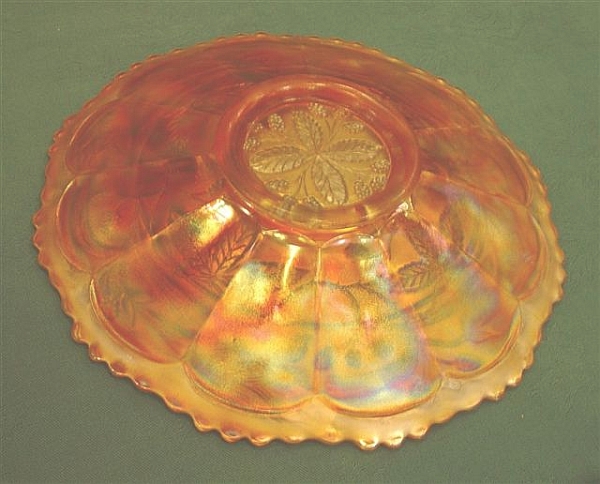 |
|
Murky overspray into marie area.
|
We handled and took photos of a mgld. Wild Blackberry example of this disgusting makeover process while attending a convention. The mgld. overspray appears as bright as the recently developed new marigold spray, created by an enterprising employee of Fenton Glass. This “plate” was advertised as a “first”. There was not a single bid from the house, indicating that those in attendance knew what they were looking at. It sold to a “mail-bidder”? for $2500?? Should that have been a legitimate' first-known Wild Blackberry plate, the price would quite possibly have been in the five figure range! A 3-1 edge bowl in this pattern will measure about 8 ½”. These flattened pieces are approx. 9” in diameter. Regarding smooth edge versus tooth edge seen in our Wild Blackberry photos: We once owned a lovely six ruffle marigold bowl having smooth edge. Currently, we own an amethyst 3-1 edge bowl having tooth edge, indicating that two different exterior moulds were used with the interior plunger.
Further: We have been warning the carnival glass community of this nasty practice for quite sometime. You may read further accounts on our website: www.carnivalglass101.com . The most recent appears in Fenton - Part 6 listed on our homepage. As many can attest, we have been actively participating in and promoting the carnival glass community for more than 40 years, writing educational articles for many Club newsletters, chartering the San Diego Club in 1985, serving as its President for six years, serving on the ICGA Board for two terms, presenting banquets and seminars at conventions. We speak only in terms of enlightenment and for the benefit of those collectors who enjoy the beauty and value of carnival glass as it was originally manufactured and intended. It should also be emphasized that we never make statements without a foundation of TRUTH!
Many of you know us to be serious and concerned about the dangers of accepting or overlooking these makeovers. THEY MOST CERTAINLY DO EXIST, or you can be utterly certain that we would NOT have broached the subject in earnest. We do not deal in rumor. They account for some of the gradual decline in price/desirability of certain formerly “rare” species of plates! This awareness does nothing to enhance nor encourage newcomers to collecting carnival glass, but acceptance of FACT is absolutely necessary if collecting the glass is to continue to be a viable pleasure. These hoaxes have already become entrenched into the volume of turn-over glass. It's time to recognize them for what they are and not brush their existence aside. If you find that you own one of these items, you will perform a great service to future collectors in simply admitting the error in judgment at time of purchase, vowing never to send them to auction or attempting to re-sell . In re-selling such makeovers, character and reputation are at stake!
Have any of you ever wondered about the derivation of so many ice green Peacocks plates, versus a more mint green found amid the extremely few “mint ice green” bowls in that pattern? Have you ever marveled that the bowls will always sell for more than any of those plates? The plates usually sell in the $300-$400 range. There is a long story surrounding manufacture of those plates in a garage along an alley in St. Louis!
How much would you pay for a “whimsey”, if you knew that sometime ago, someone had reheated a tumbler to create it? And what about the so-called spittoons, some of which are makeovers from rosebowls? A couple of those even carry cracks resulting from the reheating process. Then we should question some of the made-over “banana boat” shapes as well. The perpetrators of many of those pieces are now long gone from our midst, but there was serious discussion of such when we first joined the Southern California Club in Los Angeles in 1981. Bill Carroll, Charles Adams and Wesley Strain were still alive in those days and “their stories” were full of valid information. You would be appalled at some of the names indicated in connection with those “peculiarities”.
Oh YES! We should mention the so-called Millersburg “plate” in Rays and Ribbons which sold over eBay sometime ago. Friends in CA purchased that one over eBay and another CA friend/dealer/collector tells us they all realized the peculiarities in that one when it arrived and received due scrutiny!
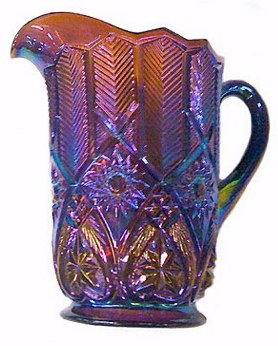 |
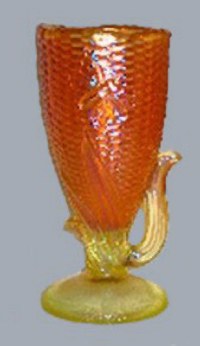 |
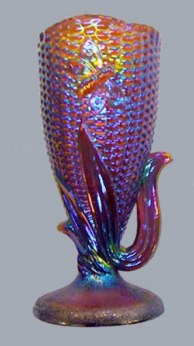 |
FEATHER and HEART
in Amethyst.
|
BUTTERFLY CORN
vase in Vaseline.
|
BUTTERFLY CORN
Vase.
|
Surely, as you gaze upon the Feather and Heart pitcher, knowing it to be of Millersburg origin, you're admitting to never having seen one in that finish/coloration? While you ponder at that peculiarity, we shall continue to say that in discussing the origin of the Butterfly Corn vase with three devout Mlsbg. collectors, dismissal of it being from Millersburg production was unanimous! The vase is light in weight, and possibly of Fenton origin. One of the U.S. Glass Companies should not be ruled out as perpetrator either. Does it not strike you as somewhat strange that these two pieces appear to be from the same “re-make artist”? Aside from the fact that old moulds are scattered now, and no doubt in the hands of some “clever ones”, the newer color sprays, as observed on these light amethyst examples, offer very different results. (This is the reason, determining the newer carnival glass items from the vintage types is fairly easy!) The vaseline Butterfly Corn vase is legitimate, and you may view several other such legitimate examples in this pattern by going to our FENTON - Part 7 and CORNY CONTAINERS segments on the www.carnivalglass101.com site.
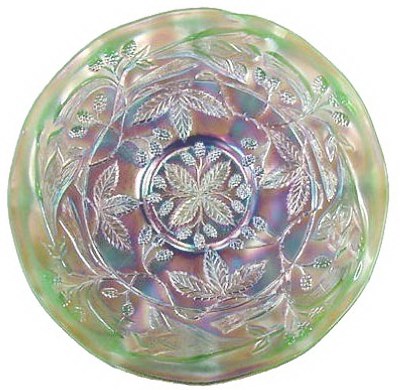 |
Green WILD BLACKBERRYmakover from Ebay-11-2008 - $2025.75.
|
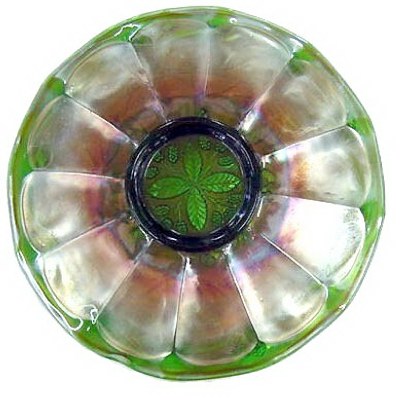 |
Reverse of Green WILD
BLACKBERRY Bowl - (plate)
|
Photos of the latest “very questionable” green Wild Blackberry plate” shown here indicate the “improved methods to defraud and contort”. Reality and presence of mind should indicate that with passage of more than 100 years since Fenton produced the bowls in this pattern, IF a plate had been produced, the likes of those who seek the unusual would have found it many years ago! The late Don Moore was a great admirer of the unusual, and possessed the where-with-all to purchase whatever was offered. Should such as these Wild Blackberry items have been available, certainly he would have been a “target”! We cannot confirm that the “plate” shown here is the same example which sold during the Aug. 2009 WWWCGA Convention held in Greenville, OH, but appearances indicate that distinct possibility.
A diagram of the Wild Blackberry design is shown in Hartung Book 5-page 80, stating it was made in bowls. FENTON GLASS - The First Twenty-Five Years, page 24 also lists only bowls as having been produced in the pattern.
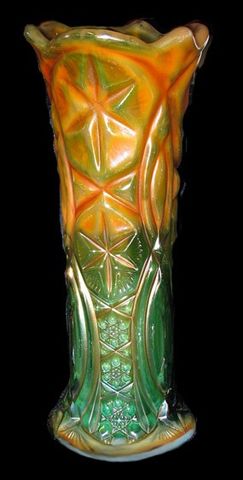
OHIO STAR vase (mucked up with GOOK!)
The same “reality test” applies to this miserably distorted Ohio Star vase!! WHY would anyone deliberately destroy an otherwise perfectly lovely green vase with such an ugly application of “muck”? Re-heating of the upper portion has eliminated some of the design. Perhaps to that experimenter, the ugly results look like DOLLAR SIGNS??!!
Be wise! Scrutinize and question what takes your eye. Learn all you can about the devious side of collecting, and above all, make your own decisions about what to purchase………You will all be better collectors for not taking everything you see, for granted………….What you see is not always what you should buy! (smile)
Some individual names of persons and places involved, have been withheld from this writing.
Happy Collecting from this couple who love Carnival Glass (and its true admirers) with passion and wholeheartedly look forward to a “healthy” future in collecting legitimate-factory-made “vintage” glass.
A recently made remark that carnival glass has lost some of its `story-tellers' in recent years brings up a good point! So long as we draw breath, these two `old-timers' will relate true fact, just as we promised the late Don Moore before he passed away in the early `90s. Don was a story-teller extraordinaire'! We (tell it like it is, just as Don always did!) You can depend on it!~
Confidently Trust the Lord!
Dean & Diane Fry, 10/09
Peace is not to be purchased by the sacrifice of Truth --- John Calvin
Therefore having been justified by faith, we have peace with God through our Lord Jesus Christ,
Through whom also we have access by faith into this grace in which we stand, and rejoice
In hope of the glory of God.
And not only that, but we also glory in tribulations, knowing that tribulation produces perseverance;
and perseverance, character; and character, hope.
Now hope does not disappoint, because the love of God has been poured out in our hearts by the
Holy Spirit who was given to us. (Romans 5: 1-5)
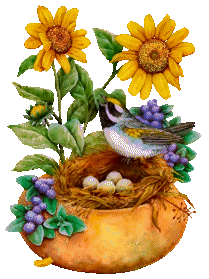
Should you care to contact the Frys, their email address is:
Search Carnival Glass 101
back to Carnival Glass 101
Our other sites you may enjoy:
Everything you EVER wanted to know about Indiana Glass
Great Reference for Newer Carnival Glass.
Complete Glassware Catalogs Available to Download
Questions? Comments? Suggestions? Broken Links? Corrections?
Your Friendly Webmaster is here to help!
